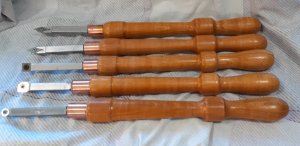chaoticbob
Established Member
Sorry if these are naive questions, but I have to start somewhere...
I'm primarily a metal worker, but recently had to make some wooden plinths to wall-mount a project:

I turned these from square blanks on a metal-turning lathe using the 'knife tool' shown. It went surprisingly well.
Obviously doing this sort of thing with a tool mounted on the carriage of an engineering lathe is limited to making straight cuts unless one grinds custom profile tools, so I began to wonder about using 'proper' wood turning techniques. I would like to make more ornate plinths - perhaps like the bases of table lamps to give an idea of what I'm after.
I had a look round on youtube and came across a 'using the skew chisel' video by Allan Batty. Well, that looks easy enough I thought (!), so I made a 19mm skew from a length of tool steel I had handy. Disaster! Ruined a couple of blanks and my nervous system with dig-ins. Trying to run before I could walk I suppose.
So, to get to the point, I'm thinking maybe a spindle gouge would be more forgiving, and that's what I want? But so many types out there - roughing, fingernail, detail &c &c. Or do I need more than one tool as I'm aiming to cut both face, edge and end grain?
Apologies if this is a bit rambling, but I'm confused!
Any guidance would be most welcome.
Bob.
I'm primarily a metal worker, but recently had to make some wooden plinths to wall-mount a project:

I turned these from square blanks on a metal-turning lathe using the 'knife tool' shown. It went surprisingly well.
Obviously doing this sort of thing with a tool mounted on the carriage of an engineering lathe is limited to making straight cuts unless one grinds custom profile tools, so I began to wonder about using 'proper' wood turning techniques. I would like to make more ornate plinths - perhaps like the bases of table lamps to give an idea of what I'm after.
I had a look round on youtube and came across a 'using the skew chisel' video by Allan Batty. Well, that looks easy enough I thought (!), so I made a 19mm skew from a length of tool steel I had handy. Disaster! Ruined a couple of blanks and my nervous system with dig-ins. Trying to run before I could walk I suppose.
So, to get to the point, I'm thinking maybe a spindle gouge would be more forgiving, and that's what I want? But so many types out there - roughing, fingernail, detail &c &c. Or do I need more than one tool as I'm aiming to cut both face, edge and end grain?
Apologies if this is a bit rambling, but I'm confused!
Any guidance would be most welcome.
Bob.








































